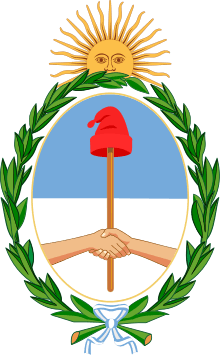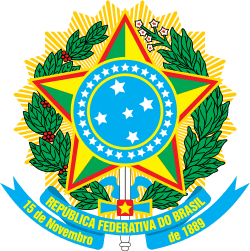Argentina–Brazil relations
 |
|
Argentina |
Brazil |
|---|---|
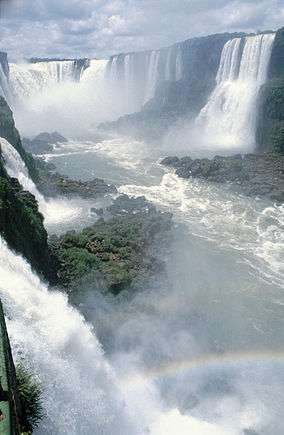
Relations between the Argentine Republic and the Federative Republic of Brazil are both close and historical, and encompasses all possible dimensions: economy, trade, culture, education and tourism.[2] From war and rivalry to friendship and alliance, this complex relationship has spanned more than two centuries.
After achieving independence from the Iberian crowns in the early nineteenth century, Argentina and Brazil inherited a series of unresolved territorial disputes from their colonial powers. The most serious breach in the relationship was the Cisplatine War (1825–1828), led by the Brazilian invasion and annexation of the Banda Oriental. Despite the numerous periods of muted hostility, the Argentine–Brazilian relationship was not defined by open hostility for most of the nineteenth and twentieth centuries. There was competition on many levels, and their respective defense policies reflected mutual suspicion, but the Brazilian economic rise in the 1980s led to the accommodation of Argentina as a secondary regional power and increasing cooperation.[3]
With the creation of the Brazilian–Argentine Agency for Accounting and Control of Nuclear Materials in 1991, the two countries turned their nuclear competition into cooperation through mutual confidence.[4] A high volume of trade and migration between Argentina and Brazil has generated closer ties, especially after the implementation of Mercosur in 1991.[5] Today, the strategic relationship between Argentina and Brazil is considered to be "at the highest point in history".[6] Argentine foreign policy has given special emphasis in "deepening the strategic alliance with Brazil in all its aspects".[7] Likewise, Argentina has been "an absolute priority" for Brazilian foreign policy.[8]
Overview
Argentina and Brazil are neighbouring countries of South America, and two of the most important economies in South America. The two countries combined represent 63% of the total area of South America, 60% of its population and 61% of its GDP.[9]
History
Independence and consolidation
Argentina and Brazil share the Río de la Plata basin– an area where Portuguese and Spanish conquistadors collided in their ambition to conquer new land for their respective crowns. After achieving independence from the Iberian crowns in the early nineteenth century, the Argentine Republic and the Brazilian Empire inherited a series of unresolved territorial disputes from their colonial powers, involving Paraguay and Uruguay, the other two nations of the Río de la Plata basin.

It was during this time that the Cisplatine War, the first armed conflict between both countries, started. From 1825 to 1828 the forces of the United Provinces of the Río de la Plata outfought those of the Brazilian Empire, until the signing of the Treaty of Montevideo that gave independence to Uruguay from both countries. Given the high cost of the war for both sides and the burdens it imposed on trade between the United Provinces and the United Kingdom, the latter pressed the two belligerent parties to engage in peace negotiations in Rio de Janeiro. Under British and French mediation, the United Provinces of River Plate and the Empire of Brazil signed the 1828 Treaty of Montevideo, which acknowledged the independence of the Cisplatine Province under the name Eastern Republic of Uruguay. Troops of both countries would face each other once again later, during the Platine War, when a coalition of Brazil, Uruguay and Argentine rebels managed to defeat Rosas (helped in turn by Uruguayan rebels led by Manuel Oribe). Another war almost happened during the 1870s when Brazil refused to accept Argentina's desire to take all the Chaco region for itself after the end of the Paraguayan War (also known as the War of the Triple Alliance) when both countries were allies against Paraguay.
Brazil did not settle disputes with Argentina over its precise national boundaries until the early twentieth century. It had settled with Uruguay in 1851, with Peru in 1851 and 1874, with Colombia in 1853, with Venezuela in 1859, with Bolivia in 1867 and with Paraguay in 1872,[10] but not with Argentina, Guyana, French Guyana and Suriname. However, it had consolidated most of its vast territory under a single authority by the middle of the nineteenth century, achieved as the result of the work of the empire's political elite. In contrast, the Argentine Republic's nineteenth century experience was marked by infighting between contending factions—those favoring a federalist republic—struggling against the strong centralist tendencies of the city of Buenos Aires (Unitarians). Argentina's unification and territorial consolidation under a single authority was completed by the 1880s.
Consolidated states

Despite this inheritance of unresolved territorial disputes and numerous periods of muted hostility, the Argentine–Brazilian relationship was not defined by open hostility for most of the nineteenth and twentieth centuries. There was competition on many levels, and their respective defense policies reflected mutual suspicion, but their bilateral relationship was not adversarial. After the mid-1850s, neither country resorted to coercion or the use of force to resolve territorial disputes, and during the only general war that took place in the Plata region– the Paraguayan War (1864–1870)– Argentina and Brazil were allied against Paraguay.
Twentieth Century

Argentina and Brazil perceived each other as rivals, not enemies. Indeed, since their consolidation as viable nation-states in the late nineteenth century and until the mid-1980s, both countries kept a mutual distance from each other, despite sharing the abundant natural resources of the Río de la Plata basin. For most of the twentieth century, their physical integration was hampered by security concerns, particularly following World War II. With the growing influence of the armed forces in their respective body politics– in particular the rise of Germanic influences among members of the civilian and military elites– priority was given to defending their national territories against a potentially aggressive neighbor.
Consequently, communication and physical integration between the two neighbors was limited. The benefits of developing closer economic, political, and cultural relations were not considered until very recently.
Since 1945, the most acrimonious bilateral dispute concerned the control of water resources along the Alto Paraná basin. In 1966, Brazil and Paraguay concluded the Iguaçu Act, announcing their intention to build a Brazilian–Paraguayan hydroelectric plant, Itaipú dam, on the Paraná River, on the Argentina–Brazil–Paraguay border. The Treaty of Itaipú was signed in Brasília in 1973. However, Buenos Aires feared that Brazil's project would hinder its own plans for the water resources development in the area. For almost a decade, the dispute soured bilateral relations and hampered efforts to forge closer economic and political links.
The dispute over water resources was finally resolved by intense diplomatic negotiations. In October 1979, the Itaipú–Corpus Multilateral Treaty on Technical Cooperation was concluded, ending the dispute to the satisfaction of all three neighbors and opening the way for a dramatic improvement in relations. After the conclusion of the Itaipu–Corpus Treaty, Brazilian president João Figueiredo visited Argentina, the first Brazilian leader to do so in more than four decades.
Figueiredo, the last president of the military rulers who had governed Brazil for 21 years, visited Buenos Aires in May 1980 and signed, among other agreements, a series of accords to collaborate on nuclear issues. Reflecting their shared opposition to the nuclear non-proliferation regime, Argentina and Brazil agreed to co-operate and exchange technical information, materials, and products on all aspects of the nuclear fuel cycle.
Following the resolution of the water resources dispute and the Brazilian president's successful visit, an unexpected and traumatic event took place in Argentina that further improved bilateral relations: the 1982 Falklands War.
Falklands War
Three years after calling off the Operation Soberania in order to invade the Picton, Nueva and Lennox islands, Argentina invaded the Falkland Islands (Spanish: Islas Malvinas) on April 1982, starting a brief but important war with the United Kingdom. Brazil supported the Argentine claim over the Falkland Islands:
After reviewing the issue regarding the Falkland Islands, His Excellency the President of the Federative Republic of Brazil expressed the support of his Government to the Argentine Republic, reaffirming his belief that the negotiations in progress will yield satisfactory results within a brief amount of time.
On June 3, 1982, a British Vulcan diverted to an emergency landing in Brazil when its in-flight refueling probe broke en route to Ascension Island after bombing Argentine positions in the Falkland Islands. The crew sent a "Mayday" signal, jettisoned classified documents, and attempted to ditch its missile armament, but all bar one malfunctioned and remained on the plyons. The Vulcan was intercepted by Brazilian F-5 Tiger II jets and escorted to the Galeão Air Force Base in Rio de Janeiro, where the crew and aircraft were interned.[12][13][14] After diplomatic negotiations with the United Kingdom, the aircraft and crew were released on June 11. However, the remaining Sidewinder and AGM-45 Shrike missiles on board the aircraft were confiscated by the Brazilian authorities. After hostilities ended in June 1982, Buenos Aires chose Brazil to represent its interests in London until full diplomatic relations with United Kingdom were restored in 1990. Thus, despite rivalry and historical suspicions, Brazil's actions and policies during the most traumatic period of Argentina's recent history—objectionable military rule, near-conflict with Chile and the Falklands War—were fundamental to build trust between the two countries.
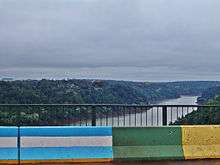
Argentina's defeat in the war against Britain hastened the end of its domestic military rule. General elections were held in October 1983, and President Raul Alfonsín was elected with a mandate to ensure that Argentina's recent past was not repeated. Among his main achievements, President Alfonsín started to resolve the enduring territorial conflict with Chile during his six-year term, and significantly improved relations with Brazil.
Argentina's intention to forge a closer relationship with Brazil was matched by Brazil's intention to do the same. While still under military rule, Brazil initiated a policy of improving relations with its South American neighbors, and Argentina was considered the key country in this effort. The initiative was accelerated after 1985 when José Sarney, became the first civilian president of Brazil since 1964. Soon after taking power, President Sarney met with President Alfonsín, and thereafter a series of diplomatic initiatives and presidential visits took place. The aim of these exchanges was to deepen the process of cultural, political, and economic rapprochement between Argentina and Brazil.
Democratization (1985)
After democratization, a strong integration and partnership began between the two countries. In 1985 they signed the basis for the Mercosur, a regional trade agreement.
In the field of science, the two regional giants had been rivals since the 1950s when both governments launched parallel nuclear and space programs, however, several agreements were signed since then such as the creation of the Brazilian-Argentine Agency for Accounting and Control of Nuclear Materials (ABACC) to verify both countries' pledges to use nuclear energy only for peaceful purposes.
Also on the military side there has been greater rapprochement. In accordance with the friendship policy, both armies dissolved or moved major units previously located at their common border (e.g. Argentine's 7th Jungle and 3rd Motorized Infantry Brigades). Brazilian soldiers are embedded in the Argentine peacekeeping contingent at UNFICYP in Cyprus and they are working together at MINUSTAH in Haiti and, as another example of collaboration, Argentine Navy aircraft routinely operates from the Brazilian Navy carrier NAe São Paulo.
Recent years
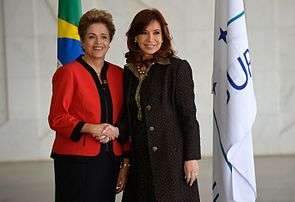
The Néstor Kirchner administration placed Brazil as a foreign policy priority and relations with Brazil were considered strategic.[15] This was met with reciprocity in Brazil, as Lula da Silva placed Argentina as the main priority of his foreign policy.[16] It should be emphasized, that the first foreign visit of Lula da Silva, as president-elect, was to Argentina in December 2002.[16] From the Brazilian perspective, only with this strategic alliance would it be possible to transform South America into a world power bloc, one of the goals of Lula da Silva's foreign policy.[17]
Since 2003, Argentina and Brazil have coordinated their positions in the multilateral fora, as can be seen by their joint participation in the agricultural negotiations at the WTO meeting in Cancún, their joint position in regards to the creation of the Free Trade Area of the Americas, and their articulation at the G-20 to reform the international financial system.[16] The creation of the Union of South American Nations, in 2008, was a landmark in the new foreign policies of Brazil and Argentina.[16] In another sign of mutual trust, since 2003, diplomats from both countries occupy a single seat in the United Nations Security Council when either of them hold a non-permanent seat.[18]
In the economic arena, Argentina and Brazil dropped the U.S. dollar and started using their own currencies on all bilateral commercial transactions in 2008.[19]
On September 6, 2008, the President of Argentina, Cristina Kirchner, traveled to Brazil to consolidate relations between the two countries. She was the guest of honor at the Independence Day celebrations that took place on September 7, 2008 and witnessed the military parade in Brasília. The following day, she held discussions with President Lula on a variety of bilateral issues including energy, defense and nuclear cooperation.[20][21]
On October 28, 2010 president Lula da Silva traveled to Buenos Aires to give his condolences for Néstor Kirchner's death.[22] The Brazilian Government declared three days of national mourning.[23]
"Our alliance with Brazil is indestructible"
— Foreign Minister Héctor Timerman.[24]
President Dilma Rousseff chose Argentina as the first foreign trip of her presidency, in a demonstration of the "special and strategic" ties between the two countries.[25] During her state visit to Buenos Aires on January 31, 2011, Rousseff stated that "it was not a casual decision to pick Argentina as my first foreign destination" and praised Argentina as a "strategic ally" to her country.[26] "The Brazilian government assumes, once again, a true commitment with the Argentine government as well as a joint policy intended to promote a development strategy for the region. For me the main idea is that of a strategic relationship with Argentina, which should shine itself in all areas of interest of both countries", said Rousseff in conversations with local newspapers before arriving in Buenos Aires.[27]

Current issues
Military cooperation


Brazil and Argentina are engaged in several joint venture projects in the military field, such as the Gaucho armored vehicle and the Embraer KC-390 military transport aircraft. The Gaucho is a Light Strike Vehicle capable of reconnaissance, air assault, command and control, transport and evacuation missions.[28] The Gaucho project started in 2004 and entered production in 2006.[28] Argentina is responsible for the design and construction of the chassis, engine mounts, transmission, steering and suspension.[28] Brazil, for its part, developed and installed the brake system, engine, transmission and transfer case, as well as the cooling system, electrical system, fuel, armament and accessories.[28]
Brazil and Argentina have also entered a partnership to jointly develop the KC-390 twin-engine military transport aircraft.[29] Argentina has agreed to manufacture KC-390 components and possibly purchase six of the aircraft.[29]
The Argentine Army has shown interest in a possible version of the 8x8 armored vehicles VBTP-MR Guaraní developed by the Brazilian Army with the support of Iveco. The Argentine military are also operators of the Brazilian military Agrale Marruá vehicle.
Scientific cooperation
Argentina and Brazil have close cooperation in the field of space science – the National Space Activities Commission of Argentina and the Brazilian Space Agency have been working together since the 1990s. In 2007, Brazil and Argentina successfully launched a rocket into space, in the first joint space mission by the two countries. The VS-30 rocket was launched from the Barreira do Inferno Launch Center and carried experiments from both countries.[30]
The Brazilian–Argentine Agency for Accounting and Control of Nuclear Materials was created in 1991. During President Lula's state visit to Buenos Aires on February 22, 2008, the two countries established a binational commission on pursuing joint uranium enrichment for nuclear energy purposes.[20][31]
Falkland Islands

The Brazilian government has been a strong supporter of the Argentine claim over the Falkland Islands[32] – which both countries term Malvinas (Brazil: Ilhas Malvinas / Argentina: Islas Malvinas).[33]
In a joint communiqué issued by the Brazilian and Argentine governments on August 3, 2010, "the President of the Federative Republic of Brazil reiterated the support of his country to the legitimate rights of Argentina in the sovereignty dispute regarding the Falkland Islands, South Georgia and South Sandwich Islands and the surrounding maritime areas".[34] The Brazilian government also stressed that the exploration of offshore oil that the United Kingdom carries out in the Argentine continental shelf is "illegal" and "inconsistent with what determines the United Nations".[34]
Brazilian authorities have also voiced their support for the Argentine claim at the multilateral fora, including the United Nations, the Rio Group, Mercosur, the Organization of American States, and Unasur.[35] Brazil has criticized the United Nations for not acting on the sovereignty of the Falkland Islands,[36] and accused the United Kingdom of using its status as permanent member of the Security Council to prevent the debate from being reopened.[36]
In accordance with a resolution adopted at the 2010 South American Summit prohibiting British vessels operating under the "illegal flag of the Malvinas (Falkland Islands)" from docking at South American ports,[37] the government of Brazil denied the British ship HMS Clyde access to Rio de Janeiro on January 11, 2011.[38] In a statement, the Brazilian Minister of Defense, Nelson Jobim, noted that Brazil "recognizes Argentine sovereignty over the Malvinas (Falkland Islands) and not the British claim" and therefore "will not authorize any requests made from British ships or aircraft in military operations in the Falklands".[39]
Trade and investment
Trade
Brazil accounts for Argentina's largest export and import market,[40] while Argentina accounts for Brazil's third largest export and import market. Total trade between the two countries amounted to the sum of US$32.9 billion in 2010.[41]
| 2004 | 2005 | 2006 | 2007 | 2008 | 2009 | 2010 | |
|---|---|---|---|---|---|---|---|
| |
$5.6 billion | $6.2 billion | $8 billion | $10.4 billion | $13.3 billion | $11.3 billion | $14.4 billion |
| |
$7.4 billion | $9.9 billion | $11.7 billion | $14.4 billion | $17.6 billion | $12.8 billion | $18.5 billion |
| Total trade | $13 billion | $16.1 billion | $19.7 billion | $24.8 billion | $30.9 billion | $24.1 billion | $32.9 billion |
| Note: All values are in U.S. dollars. Source: MRE[40]/SECEX.[41] | |||||||
Investment
Argentina is the main destination for Brazilian investment in South America.[5] Brazilian investments in Argentina are mostly in oil, cement, mining, steel, textiles, cosmetics, banks, food, and beverages.[5] According to the United Nations Economic Commission for Latin America and the Caribbean, forty percent of direct investment in Argentina comes from Brazil.[5]
State visits
Since 2003, Presidential meetings are held every six months alternately in each country,[42] and besides those there are more for other reasons (UNASUR, Mercosur, G20, etc.).
- Recent visits by the President of Brazil to Argentina

- Luiz Inácio Lula da Silva
- May 22–25, 2003, Buenos Aires - Inauguration of Néstor Kirchner as President of Argentina[43]
- October 15–18, 2003, Buenos Aires and El Calafate - Official state visit[43]
- July 7–8, 2004, Puerto Iguazú - Mercosur summit and private meeting with President Néstor Kirchner[44]
- November 4–5, 2005, Mar del Plata - 4th Summit of the Americas[45]
- November 30, 2005, Puerto Iguazú - Presidential meeting with Néstor Kirchner[45]
- May 4, 2006, Puerto Iguazú - Quadripartite meeting between the heads of state of Brazil, Argentina, Bolivia and Venezuela[46]
- July 20–21, 2006, Córdoba - Mercosur summit[46]
- April 26–27, 2007, Buenos Aires - Official state visit[47]
- December 9–10, 2007, Buenos Aires - Inauguration of Cristina Kirchner as President of Argentina[47]
- February 21–23, 2008, Buenos Aires - Official state visit[48]
- June 30 July 1, 2008, San Miguel de Tucumán - Mercosur and Unasur summits and private meeting with Cristina Kirchner[48]
- August 3–4, 2008, Buenos Aires - Official state visit[48]
- April 22–23, 2009, Buenos Aires - Official state visit[49]
- August 27–28, 2009, Bariloche - Unasur summit and private meeting with Cristina Kirchner[49]
- May 3–4, 2010, Buenos Aires - Unasur summit and private meeting with Cristina Kirchner[50]
- May 25, 2010, Buenos Aires - Guest at the Argentine bicentennial celebration[50]
- August 2–3, 2010, San Juan - Mercosur summit and private meeting with Cristina Kirchner[50]
- October 27, 2010, Buenos Aires, Death and state funeral of Néstor Kirchner[51]
- Dilma Rousseff
- January 31, 2011, Buenos Aires - Official state visit[52]
- December 10, 2011, Buenos Aires, swearing-in ceremony of Cristina Fernández de Kirchner's second term as president.
- June 28–29, 2012, Mendoza, 43th Summit of Mercosur
- November 28, 2012, Buenos Aires, Official visit
- December 10, 2016, Buenos Aires, Presidential Inauguration of Mauricio Macri
- Recent visits by the President of Argentina to Brazil
- Eduardo Duhalde
- Néstor Kirchner
- June 11, 2003, Brasília - Official state visit[53]
- March 15–16, 2004, Brasília - Official state visit[54]
- May 9, 2005, Brasília - South America-Arab Countries summit and private meeting with President Luiz Inácio Lula da Silva[55]
- January 18–19, 2006, Brasília - Official state visit[56]
- April 25–26, 2006, Brasília - Presidential meeting with Luiz Inácio Lula da Silva[56]
- Cristina Kirchner
- May 23, 2008, Brasília - 1st UNASUL summit[57]
- September 6–8, 2008, Brasília - Official state visit[58]
- March 20, 2009, São Paulo - Presidential meeting with Luiz Inácio Lula da Silva[59]
- November 18, 2009, Brasília - Presidential meeting with Luiz Inácio Lula da Silva[40]
- July 29, 2011, Brasilia, new argentine embassy opening ceremony
- December 7, 2012, Brasilia- Presidential meeting with Dilma Rouseff
- July 14–16, 2014, Fortaleza, 6th BRICS Summit
- July 13–16, 2015, Brasilia, 2015 Mercosur Summit
Diplomacy
|
 The Brazilian Embassy in Buenos Aires.
|
See also
- Argentine Brazilian
- Foreign relations of Argentina
- Foreign relations of Brazil
- Mercosul
- Union of South American Nations
- Argentina and Brazil football rivalry
References
- ↑ Dominic Couzens 2008.
- ↑ Useful Guide for Brazilians Argentina - Official Promotion Portal for Argentina. Retrieved on 2010-11-28.
- ↑
- ↑ Brazil and Argentina's Nuclear Cooperation Carnegie Endowment. Retrieved on 2010-11-28.
- 1 2 3 4 Argentina: Rudderless Lugar, Richard G. Report: Committee on Foreign Relations of the United States Senate. Retrieved on 2010-11-28.
- ↑ No journalistic speculation can tarnish the strategic relation between Argentina and Brazil Telam. Retrieved on 2010-11-28.
- ↑ Secretaría de Relaciones Exteriores - Objetivos estratégicos Secretaría de Relaciones Exteriores. Retrieved on 2010-11-29. (Spanish).
- ↑ Relationship with Argentina shall be a priority for Rousseff, said Brazilian Foreign Minister Telam. Retrieved on 2010-11-28.
- ↑ Brasil-Argentina: uma relação estratégica Presidência da República Federativa do Brasil. Retrieved on 2009-06-23. (Portuguese)
- ↑ Vainfas, Ronaldo. Dicionário do Brasil Imperial. Rio de Janeiro: Objetiva, 2002, p. 302
- ↑ Ministry of External Relations. Resenha de Política Exterior do Brasil, nº 25, 1980, p. 54 As Relações Brasil-Argentina Durante o Governo Figueiredo (1979-1985): as etapas de um projeto necessário (p.157) (Portuguese)
- ↑ Operation Black Buck
- ↑ F-5 Tiger II IBGE.gov.br. Retrieved on 2010-11-20 (Portuguese).
- ↑ Um Vulcan inglês apanhado na rede do Cindacta Veja: June 09, 1982. Retrieved on 2010-11-20. (Portuguese).
- ↑ A Política Internacional, a Conjuntura Econômica e a Argentina de Néstor Kirchner Vadell, Javier Alberto. Revista Brasileira de Política Internacional. p. 204-211. Retrieved on 2010-11-30. (Portuguese).
- 1 2 3 4 A Cooperação Brasil-Argentina na área militar: da autonomia das Forças Armadas às relações estratégicas (1978-2009) Moraes, Rodrigo Fracalossi. UFRS. Retrieved on 2010-11-30. (Portuguese).
- ↑ A política exterior: de Cardoso a Lula Cervo, Amado Luiz. Revista Brasileira de Política Internacional. Retrieved on 2010-11-30. (Portuguese).
- ↑ El vecino como oportunidad Secretaría de Relaciones Exteriores. Retrieved on 2010-11-30. (Spanish).
- ↑ Argentina, Brazil to drop U.S. dollar in bilateral commercial transactions Xinhua. Retrieved on 2009-07-14.
- 1 2 Argentina, Brazil consolidate relations G15. Retrieved on January 17, 2008.
- ↑ Brazil and Argentina's Nuclear Cooperation NPS Global. Retrieved on 2009-06-23.
- ↑ Lula: 'Kirchner was able to pull Argentina out of the pit it was in' Buenos Aires Herald. Retrieved on 2010-10-28.
- ↑ Lula decreta luto de três dias e diz que Kirchner era 'fraternal amigo' Estadão. Retrieved on 2010-10-28. (Portuguese).
- ↑ 'Our alliance with Brazil is indestructible,' Timerman says Buenos Aires Herald. Retrieved on 2011-01-31.
- ↑ Rousseff to make first foreign visit in Argentina Channel News Asia. Retrieved on 2011-01-31.
- ↑ 'I'm here to make our relationship stronger than ever,' Rousseff Buenos Aires Herald. Retrieved on 2011-01-31.
- ↑ Dilma Rousseff Makes First Trip Abroad As President to Argentina MercoPress. Retrieved on 2011-01-31.
- 1 2 3 4 Gaucho vehicle data sheet WarWheels. Retrieved on 2011-01-22.
- 1 2 Argentina joins Brazil’s development of military cargo aircraft MercoPress. Retrieved on 2011-01-22.
- ↑ Brazil, Argentina launch space rocket USA Today. Retrieved on 2009-07-14.
- ↑ Argentina, Brazil pledge nuclear ties Forbes. Retrieved on 2009-07-14.
- ↑ Falklands/Malvinas: Brazil joins Argentina in criticizing UK’s "unilateral actions" Mercopress. Retrieved on 2010-11-27.
- ↑ ONU convoca Reino Unido e Argentina para negociar posse das Malvinas Ministério das Relações Exteriores. Retrieved on 2010-11-30. (Portuguese).
- 1 2 Declarações adotadas no encontro do Presidente Luiz Inácio Lula da Silva com a Presidenta da Argentina, Cristina Fernández de Kirchner - San Juan, 3 de agosto de 2010: Declaração Conjunta sobre Malvinas Ministério das Relações Exteriores. Retrieved on 2010-11-27. (Portuguese) / (Spanish).
- ↑ Cuestión Malvinas: Brasil ratificó su apoyo a los legítimos derechos Argentinos de soberanía sobre las Islas Ministerio de Relaciones Exteriores, Comercio Internacional y Culto. Retrieved on 2010-11-27. (Spanish).
- 1 2 Brazil attacks UN over Falklands stand-off Times Online. Retrieved on 2010-11-27.
- ↑ Unasur unable to agree on secretary; closes all ports to ‘illegal’ Malvinas flagged vessels Mercopress. Retrieved on 2010-11-27.
- ↑ Falklands ship ban by Brazil Express.co.uk. Retrieved on 2011-01-13.
- ↑ Jobim diz que veto a navio britânico vindo das Malvinas é padrão Terra.com.br. Retrieved on 2011-01-13. (Portuguese).
- 1 2 3 Cronologia das Relações Bilaterais Ministério das Relações Exteriores. Retrieved on 2010-11-20. (Portuguese).
- 1 2 Intercâmbio Comercial Brasileiro - Argentina SECEX. Retrieved on 2011-01-22. (Portuguese).
- ↑ 'y luego visitará la República Argentina en la mecánica, que hemos adoptado desde la gestión que comenzó con mi mandato, que son precisamente reuniones cada seis meses, donde monitoreamos todas y cada una de las políticas'
- 1 2 Viagens Internacionais do Presidente da República/2003 Presidência da República. Retrieved on 2009-06-23. (Portuguese)
- ↑ Viagens Internacionais do Presidente da República/2004 Presidência da República. Retrieved on 2009-06-23. (Portuguese)
- 1 2 Viagens Internacionais do Presidente da República/2005 Presidência da República. Retrieved on 2009-06-23. (Portuguese)
- 1 2 Viagens Internacionais do Presidente da República/2006 Presidência da República. Retrieved on 2009-06-23. (Portuguese)
- 1 2 Viagens Internacionais do Presidente da República/2007 Presidência da República. Retrieved on 2009-06-23. (Portuguese)
- 1 2 3 Viagens Internacionais do Presidente da República/2008 Presidência da República. Retrieved on 2009-06-23. (Portuguese)
- 1 2 Viagens Internacionais do Presidente da República/2009 Presidência da República. Retrieved on 2009-06-23. (Portuguese)
- 1 2 3 Viagens Internacionais do Presidente da República/2010 Presidência da República. Retrieved on 2009-06-23. (Portuguese)
- ↑ Lula at Aeroparque
- ↑ Brazil's Rousseff signs energy accords in Argentina Reuters Africa. Retrieved on 2011-01-31.
- 1 2 Chefes de Estado e de Governo recebidos pelo Presidente Lula Presidência da República. Retrieved on 2009-06-23. (Portuguese)
- ↑ Chefes de Estado e de Governo recebidos pelo Presidente Lula Presidência da República. Retrieved on 2009-06-23. (Portuguese)
- ↑ Chefes de Estado e de Governo recebidos pelo Presidente Lula Presidência da República. Retrieved on 2009-06-23. (Portuguese)
- 1 2 Chefes de Estado e de Governo recebidos pelo Presidente Lula Presidência da República. Retrieved on 2009-06-23. (Portuguese)
- ↑ Cristina Fernández participa de la cumbre de Unasur Página/12. Retrieved on 2009-06-23. (Spanish)
- ↑ Chefes de Estado e de Governo recebidos pelo Presidente Lula Presidência da República. Retrieved on 2009-06-23. (Portuguese)
- ↑ Chefes de Estado e de Governo recebidos pelo Presidente Lula Presidência da República. Retrieved on 2009-06-23. (Portuguese)
External links
- Embassy of Brazil in Buenos Aires
- Embassy of Argentina in Brasília
- Ministry of Foreign Relations of Brazil
- Ministry of Foreign Relations, International Trade and Cult of Argentina
- Brazilian-Argentine Agency for Accounting and Control of Nuclear Materials
